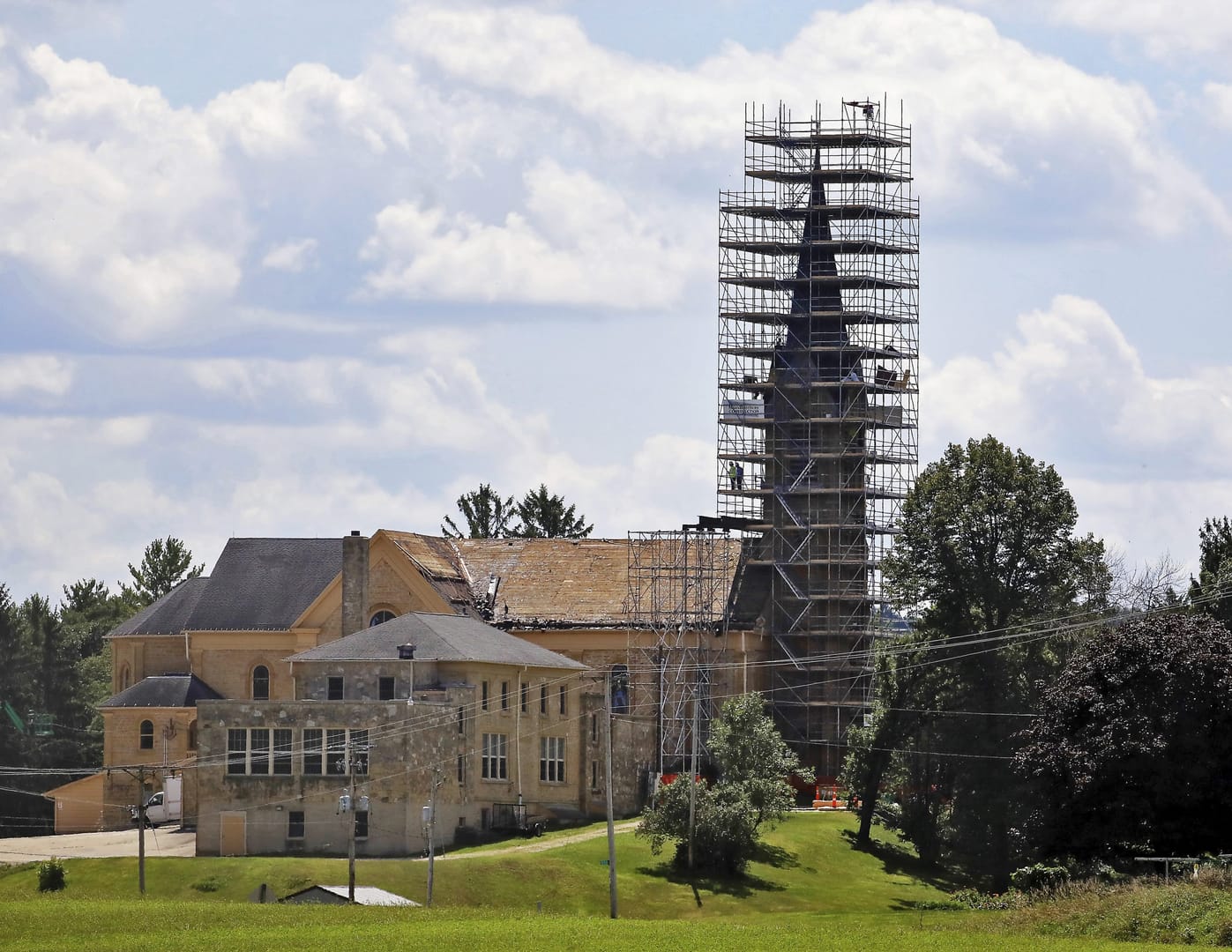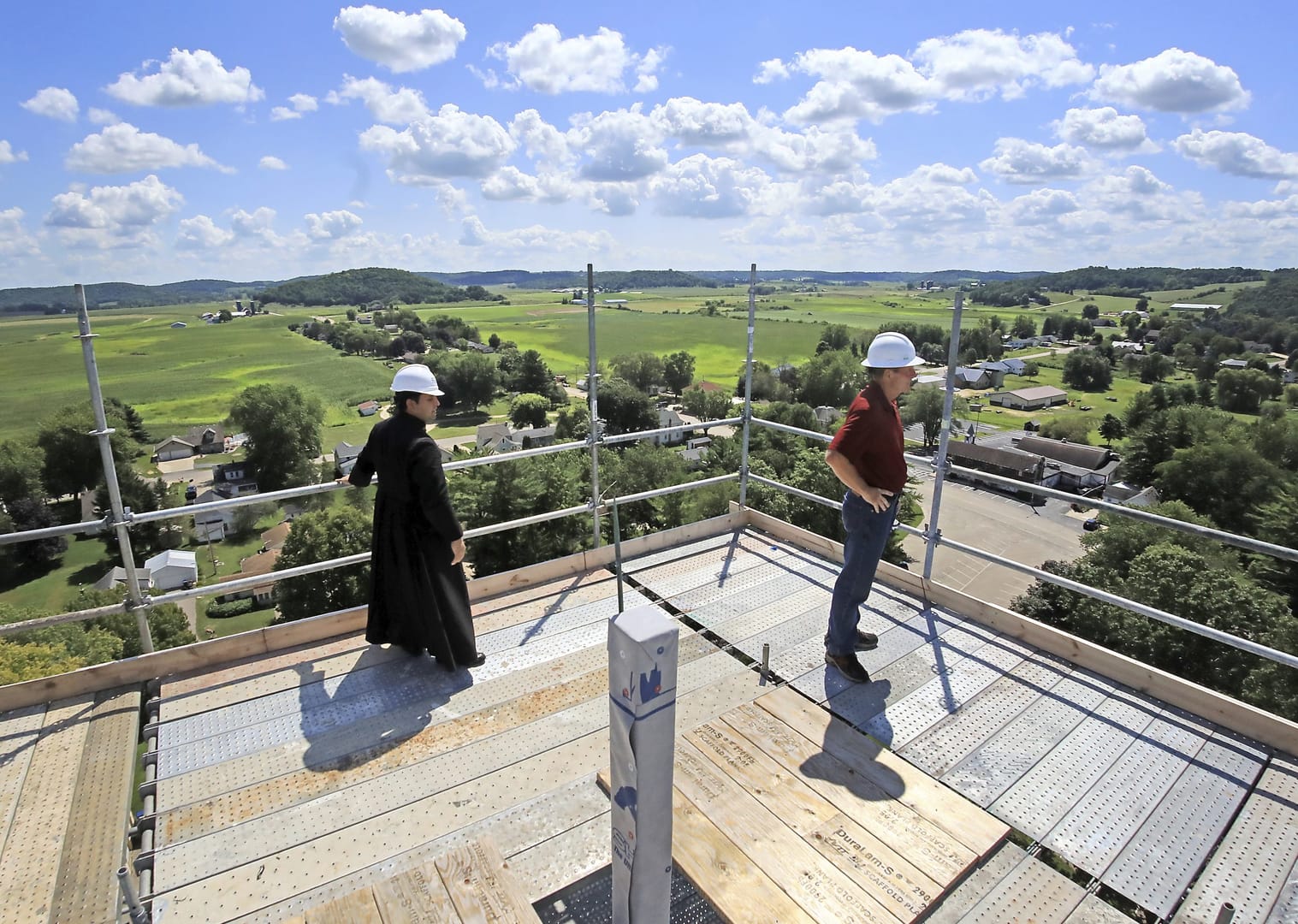TOWN OF ROXBURY, Wis. — A leaky roof has created a rare vantage point in northwestern Dane County.
The view from the top of the scaffolding that surrounds the steeple of St. Norbert Catholic Church will only be around for another month or so. But the work, which includes repairing and replacing some of the stone and mortar along with upgrades to the spire, is designed to preserve, restore and stabilize the church building. The goal of the $1.2 million project is also to ensure that one of the oldest Catholic parishes in Wisconsin remains viable, the Wisconsin State Journal reported.
Bavarian and Prussian immigrants came here before statehood and built a log cabin to serve as the church’s sanctuary. By the start of the Civil War they had mined, cut and hauled limestone out of the ground and somehow, without hydraulic cranes, lifts and power tools, assembled this house of worship that for years was a base for Father Adalbert Inama, the first resident priest in the county and considered the “Apostle of the Four Lakes Region.”
Inama, who died in 1879 and is buried in the St. Norbert Cemetery, was lured here by Austrian Count Agoston Haraszthy, who founded Sauk City and, in the 1840s, planted the first grape vines on property that is now home to Wollersheim Winery. Haraszthy promised Inama 100 acres of free land to build a church and school, which led Inama to minister in communities throughout the area, including those in what are now Sauk, Iowa, Jefferson, Dodge, Juneau and Waukesha counties. In 1849, Haraszthy bolted west to find gold, but ended up creating the California wine industry.

175-year legacy
The nearly 300 families that now make up the St. Norbert’s parish have already raised $900,000 for the renovation project despite COVID-19 and want no part of seeing an end to Inama’s nearly 175-year legacy.
“The self-sacrificing immigrants who built St. Norbert’s (relied) on their faith and wanted to make sure they had a house of faith where they could find sanctuary and peace,” said Paul Merline, a member of both the church’s finance and renovation committees. “We want to make sure we keep that for the future. We don’t want to be the group that let that slip away.”
Roxbury is located along Highway Y and a bit off the beaten path between Middleton and Sauk City. The church helped grow the community that today includes the Dorf Haus, a popular German supper club, and the Roxbury Tavern, which is closed but is being renovated for a reopening planned sometime this year according to a sign on the front of the building. The tavern, formerly a general store, was built with the same type of stone used for the church. Surrounding farmhouses, like that on the Kippley Farm, established in 1856; the nearby Frey School, constructed in 1870; and a three-floor dance hall, winery and carriage house built in 1858 at Wollersheim Winery, were also erected using limestone.
But in the case of the church, the stone work and mortar was deteriorating to the point of becoming a safety hazard despite a patchwork of repairs over the decades. Its state was discovered during an assessment of the church building after the roof issues arose in 2017.
Temporary shelters to protect parishioners from potential falling debris had been constructed over the entrances to the church.
A tall order
This spring, Maas Brothers Construction out of Watertown went to work on the project. The company has performed work on a number of churches in Watertown over the years, including at St. Bernard and St. Henry Catholic churches.
One of the first orders of business was to erect 18 levels of scaffolding more than 130 feet high that would include two 9,000-pound beams to keep weight off the church roof. Just the scaffolding project alone took three weeks to complete and gives off the appearance of a skyscraper rising from this rural community.
“This week, they’re really making some progress,” Matt Hollman, a superintendent with Maas, said of his work crews. “It’s good to have some nice weather.”
Workers recently were busy removing shingles down to the wooden planks and adding new roofing material. It’s unclear if the cross that has been removed from the spire, constructed in 1893, will be restored or replaced with a newer model. The primary work for those on the scaffolding, however, is on shoring up the stone work. Some of the stone is being replaced with rock from a Milwaukee quarry while mortar is mixed to match that used between 1852 and 1860 during the church’s construction.
Mark Stoner, an architect with Building Envelope Professionals Group in the village of Oregon, was on site Thursday inspecting the new mortar and determining if rock should be repaired or replaced. The surfaces of the stones were first cleaned to help provide a better picture to architects and engineers. Some stones have significant crumbling and need to be replaced, while others that have flaking can be treated in an effort to keep them in place for another 40 to 60 years.
“A lot of the stone, particularly the stone on the south side, just with southern exposure, you get a lot of consistent sun here, a lot of freeze/thaw, so that has deteriorated the stone quite substantially,” Stoner said. “The whole idea here is preservation. We want to keep as much of the stone original to the building on the building.”
As Stoner, who is well aware of his last name and his profession, climbed the scaffolding, he would stop at different levels, inspect stone and ask workers about the mortar used to fill in the gaps of old stone or that of new stone. He also would occasionally use his knuckles to tap on stone in search of hollow spots that could indicate wear and weakness. The mortar mixture is lime-based and needs to be softer than the limestone. A harder mortar would destroy the stone work, he said.
“They actually created a mix based on tests,” Stoner said of the work crews. “They literally took a sample of mortar, broke it down into individual components, did an analysis and then created a lime mixture based on that mixture. That’s what you’re seeing here, an historically accurate mortar.”

Worship continues
The church remains open during the construction for Masses in both Latin and English, daily prayer and a youth education program with about 100 students. The interior of the church is not being touched by the project but offers up a historical treasure trove that includes 16 large stained-glass windows and biblical statues. The basement, dug in 1892 for a parish hall, holds a tapestry of the first log church built by Inama and photos of the church through the years. The sanctuary above also holds in a reliquary, a piece of bone, called a relic, of Saint Norbert of Xanten, who died in 1134 and founded the Norbertine order on the basis of “love, selfless sharing and radical hospitality.”
There’s also a 10-foot-by-6-foot painting that hangs above the altar that was given to Inama in 1849 by King Louis II of Bavaria. The painting represents a Raphaelite Madonna, St. Jerome with a Bible, St. James with a pilgrim’s staff and a monk in a black habit.
And like the stone work on the outside of the church, the interior treasurers add to the religious experience and ambiance for those who come here to worship. The renovation project will make sure that happens for decades to come, said Father Jerry Zhanay, who has been with the parish for the past four years. Without the work and the fundraising effort, the church may have been looking at a limited existence.
“We talked to a few people, those who are more vested in the parish, and they thought we could reach the goal,” Zhanay said. “We didn’t want to close. We feel good at where we’re at.”
The church remains open during the project for Masses in both Latin and English, daily prayer and a youth education program with about 100 students.












